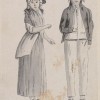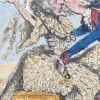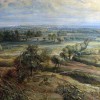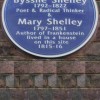
Julie M. Barst, “The Molesworth Report and the Dissolution of Convict Transportation to Australia, August 1838”
This entry focuses upon convict transportation to Australia (which spanned eight decades from 1788 to 1868) and argues that the Molesworth Report of 1838, which successfully built upon the rhetoric of the abolition movement by drawing connections between convicts and slaves, became one of the major deciding factors in eventually putting an end to the entire system of transportation. I claim that the report not only raised questions about the effectiveness of the system, but also generated sympathy for the convicts and led to a transformation in how Britons thought about the punishment of their criminal classes.

Carolyn Vellenga Berman, “On the Reform Act of 1832”
This entry examines a key moment for the British national imagination: the Great Reform Act of 1832 (or First Reform Act). It explores this crisis in aristocratic rule through the prisms of class, religion, geography, and the rise of the popular press, highlighting the concept of “representation of the people” enshrined by the act and the Age of Reform that it inaugurated.

Barbara Charlesworth Gelpi, “14 July 1833: John Keble’s Assize Sermon, National Apostasy”
This essay outlines the personal interactions and political events preceding John Keble’s delivery of a sermon later entitled National Apostasy to the judges gathered at Oxford for the Assize Court as a way of understanding the sermon’s significance in relation to the Oxford Movement.

Lisa Surridge, “On the Offenses Against the Person Act, 1828”
The early nineteenth century saw a new valuing of self-restraint and heightened social anxiety about interpersonal violence and unruly behaviour. The 1828 Offenses Against the Person Act streamlined penalties for assault, battery, rape, infanticide, attempted murder, manslaughter, and murder. It also granted to magistrates summary powers over common assaults, making prosecution of such offenses quicker and more accessible to the poor. Part of Sir Robert Peel’s larger program of legal reform, it heralded a new focus on social regulation, public order, and manliness as self-discipline.

Susan Hamilton, “On the Cruelty to Animals Act, 15 August 1876”
The Cruelty to Animals Act (15 August 1876) was the world’s first legislation to regulate the use and treatment of live animals in scientific research. This essay overviews the passage and provisions of the legislation, approaching the Cruelty to Animal Act as a site through which to examine the place of animals in clashes between an experimental medical science insisting on its professional and self-regulating status and animal welfare pressure groups that claimed a public right to shape the direction of medical science’s activities.

Mark Crosby, “The Bank Restriction Act (1797) and Banknote Forgery”
On 27 February 1797, the Bank of England suspended specie payments to preserve its dwindling bullion reserve. Less than three months later, William Pitt’s government shepherded legislation through Parliament codifying the suspension of specie payments. In place of specie, Bank of England notes became the circulating medium of currency. The smaller denomination notes, however, were very poorly produced and were copied with little difficulty and on an unprecedented scale. The governing statute for banknote forgery, which was a capital offense, did not distinguish between the production, distribution and/or handling of counterfeit notes, and hundreds of individuals were either executed or transported for unknowingly accepting and using forged banknotes. For many, the forcing of an easily imitated and alien paper currency on the population, coupled with the severe punishment designed to police this new circulating medium, was a flagrant manipulation of legislative power that prioritized commercial interests over human life.

Judith L. Fisher, “Tea and Food Adulteration, 1834-75”
This essay examines the adulteration of tea in the contexts of free trade and the politics of empire. It contends that the importance of tea as a healthful, particularly British drink made the adulteration of the beverage a significant matter for social and moral concern. Adulterated tea was primarily from China and so was typed as “foreign” and unclean in contrast to tea imported from Assam, India, that was defined as “British” and healthy.

Ellen Rosenman, “On Enclosure Acts and the Commons”
Between 1750 and 1850, approximately 4000 Enclosure Acts were passed converting commonable land into the exclusive private property of large landowners. According to the working-class politics of the late eighteenth and nineteenth centuries, these acts impoverished small farmers and destroyed the agrarian way of life that had sustained families and villages for centuries. Historians have debated this account of their effects, but for the politicized working classes the Enclosure Acts represented a profound trauma, an extended moment in a narrative of dispossession that undergirded resistance to aristocratic power and urbanization.

Amy Woodson-Boulton, “The City Art Museum Movement and the Social Role of Art”
British art museums developed along substantially different lines than those in Continental Europe. Rather than create a centrally supported or designed system of cultural provision, the British Parliament passed permissive legislation in the middle of the nineteenth century that allowed localities to choose to establish public libraries and museums. Cities thus founded art museums independently, at the instigation of committed local reformers and benefactors, while most national institutions proceeded by Parliamentary acts rather than through the nationalization of royal collections. A generation later, inspired by the works of John Ruskin and the new aesthetic of Pre-Raphaelitism, many men (and some women) pushed their cities to create art museums not primarily as a means to educate the public about art history, but to counteract the toxic effects of the moral and physical ugliness of industrial capitalism, and of industrial cities in particular. The resulting institutions formed a new kind of domesticated public space, bringing together ideas about the middle-class home as a refuge and about beauty as a means of “improving” the working classes. However, John Ruskin himself often criticized these efforts as too accommodating of industrial society.

Tom Mole, “Romantic Memorials in the Victorian City: The Inauguration of the ‘Blue Plaque’ Scheme, 1868”
The ‘Blue Plaque’ scheme, which places memorial tablets on houses in London once occupied by distinguished people, was inaugurated in 1868, when the Royal Society of Arts placed the first plaque on the house in Holles Street (off Oxford Street) where Lord Byron was born. This was the first of many plaques: at least 33 were in place by the end of the century, with more planned. The distinctive blue circular design was adopted in 1901 and the scheme continues to operate today under the management of English Heritage. This essay argues that the scheme drew on key Romantic ideas about commemorative practice, expressed by William Godwin, William Wordsworth and Samuel Rogers, as well as memorialising Romantic authors. It suggests that the “Blue Plaques” should be read in the context of a number of pantheonic initiatives undertaken during the period of the Reform agitation, which aimed to promote cultural consensus in the present, by creating consensus about the noteworthy individuals of the past.
